What woodpeckers can you see in Netherlands? There are 6 different species of woodpecker that you might encounter in Netherlands. Read this article to see pictures, hear their sound and get great information about where and when you can spot all woodpeckers in Netherlands.
The Netherlands, known for its tulip fields, historic windmills, and cycling routes, also happens to be an avian enthusiast’s delight. Beyond the common urban birds, the dense woodlands and nature reserves of this beautiful country are home to a variety of woodpeckers. These rhythm makers, with their characteristic drumming and vibrant plumage, add an auditory and visual allure to the Dutch landscape.
Let’s jump into the article.
1. Middle Spotted Woodpecker
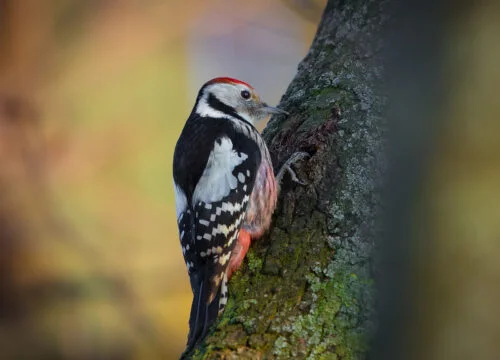
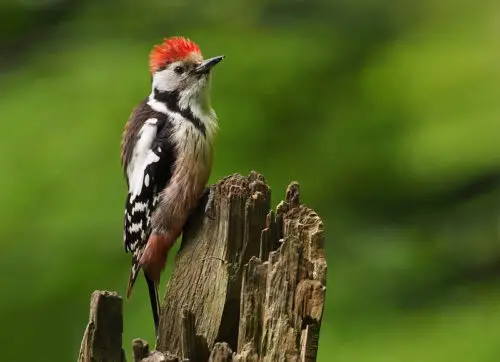
Nestled in the oak-rich forests and riparian woodlands of the Netherlands, the Middle Spotted Woodpecker is a sight to behold. With a size falling between its larger and smaller cousins, this woodpecker sports a playful palette of white, black, and rosy pink. Its distinguishing feature is the red cap that sits proudly atop its head, adding a splash of color against the dense green backdrop.
Typically found in the eastern parts of the Netherlands, especially areas like the Veluwe and the Achterhoek, the Middle Spotted Woodpecker has a penchant for old-growth forests with a mix of deciduous trees. The insect-rich bark of these trees, particularly oak, provides the ideal meal for this bird.
Unlike its more boisterous relatives, the Middle Spotted Woodpecker has a softer drumming style, often interspersed with a series of sharp calls. Observing this bird requires a keen ear and a good dose of patience, for they often flit high among the trees, making them a delightful challenge for birdwatchers.
Dutch folklore often portrays woodpeckers as messengers or weather predictors. The Middle Spotted Woodpecker, with its rhythmic drumming, is believed by some to signal the onset of spring or an impending change in weather.
A visit to the deciduous woodlands of the Netherlands, especially during the early morning hours, may just reward you with a sight or sound of the Middle Spotted Woodpecker. And in that moment, amidst the gentle rustle of leaves and the soft drumming, you’ll find a connection with the land’s age-old rhythms and traditions.
2. Great Spotted Woodpecker
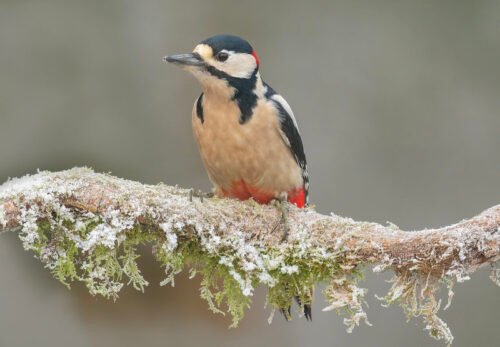
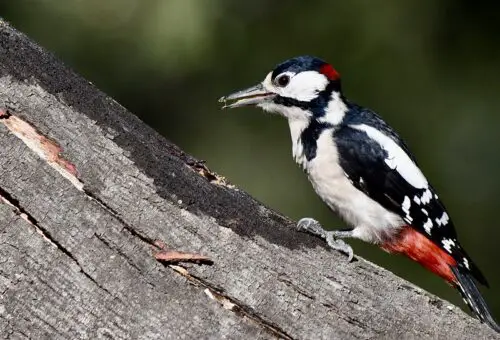
Amidst the intricate waterways and vast heathlands of the Netherlands, there’s a drummer whose beats reverberate with the spirit of the Dutch woodlands: the Great Spotted Woodpecker. As one of the most widespread and recognizable woodpeckers in the country, it stands as a proud emblem of the Netherlands’ rich avian tapestry.
Possessing a striking contrast of black and white plumage, the Great Spotted Woodpecker is an exquisite canvas of nature’s design. The male boasts a brilliant red patch on the nape, while juveniles flaunt a red crown; both are captivating sights against the verdant Dutch landscapes. The bird’s robust bill, perfect for drumming and extracting insects, emphasizes its industrious nature.
The Netherlands’ diverse woodland habitats, from the sandy dunes of the west to the dense forests of the east, are all potential stages for this woodpecker’s performance. Areas such as the Hoge Veluwe National Park or the forests surrounding Utrecht can often echo with its characteristic drumming.
Unlike many birds, the Great Spotted Woodpecker’s diet isn’t strictly seasonal. From feasting on insects during summer to enjoying a hearty meal of seeds and nuts in colder months, this bird is an adaptable forager. Its ability to cache food, storing it in crevices or under bark, ensures that it’s well-fed throughout the year.
Dutch children grow up with tales of woodpeckers as nature’s carpenters, crafting the forest and keeping it healthy. The Great Spotted Woodpecker, with its rhythmic drumming, is often celebrated in local festivals and art, symbolizing the heartbeat of the Dutch woodlands.
For those wandering the trails of the Netherlands, the percussive notes of the Great Spotted Woodpecker serve as a reminder of nature’s melodies that have been played for centuries. This bird, with its vibrant colors and persistent spirit, is a testament to the enduring beauty and resilience of Dutch nature.
3. Lesser Spotted Woodpecker
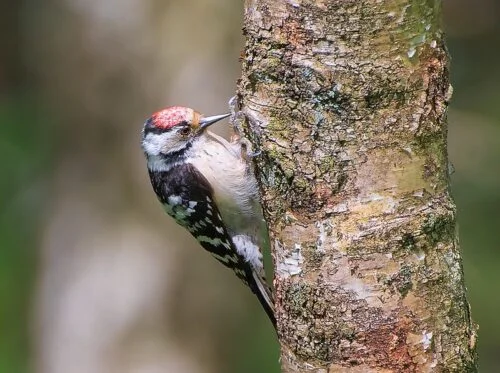
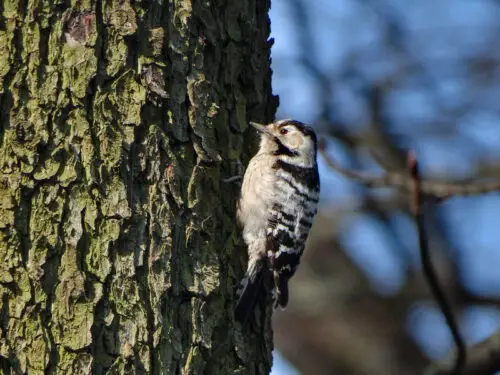
In the serene woodlands of the Netherlands, where waterways carve through lush landscapes and wildflowers dance with the breeze, there lies a subtle percussionist, a master of discretion: the Lesser Spotted Woodpecker. This diminutive drummer, with its gentle taps and muted palette, beautifully complements the bold symphony of the Dutch natural realm.
Donning a delicate ensemble of white and black, the Lesser Spotted Woodpecker is a stark contrast to its more flamboyantly colored relatives. Despite its modest appearance, it carries a touch of elegance. Males are graced with a tiny red crown, which is their pride and distinction, making them stand out amidst the foliage.
Finding a home across the Netherlands, this bird prefers deciduous forests, especially those dotted with alders, birches, and willows. Their presence is often more pronounced in regions such as the Biesbosch National Park and the marshy woods of Friesland.
This woodpecker’s diet mainly consists of small insects and their larvae, gleaned meticulously from crevices in bark or dead wood. Its drumming, unlike the bold beats of its larger cousins, is softer, almost akin to a rapid tapping, resembling raindrops on a windowpane.
The Lesser Spotted Woodpecker holds a special place in Dutch folklore. It is often seen as the forest’s secret keeper, its muted colors and soft drumming symbolizing the mysteries and whispers of the woods. Tales are spun around campfires, painting this bird as a guardian of lost treasures and woodland lore.
Venturing into the heart of the Netherlands’ forests, one might be lucky enough to catch a fleeting glimpse or hear the gentle rhythm of the Lesser Spotted Woodpecker. It serves as a beautiful reminder that in nature, even the most understated beings have profound stories to tell, echoing the age-old adage that sometimes, less truly is more.
4. Grey-headed Woodpecker
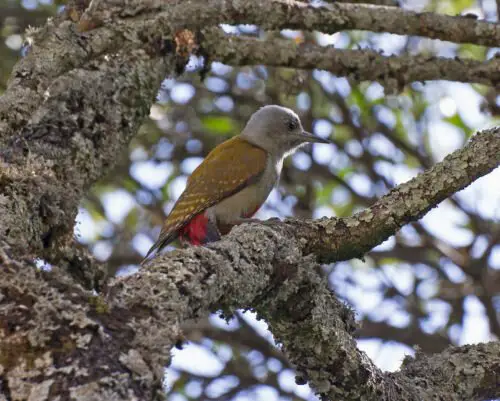
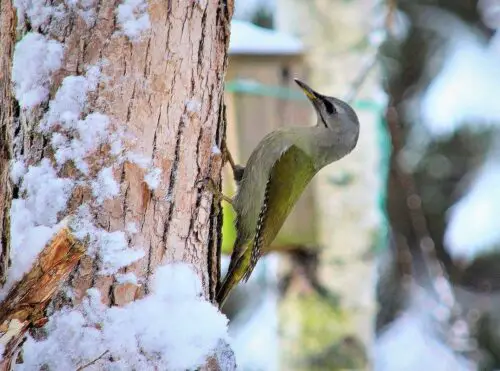
The Netherlands, with its picturesque canals, sprawling tulip fields, and vast dune landscapes, also holds within its bosom a less familiar but equally enchanting sight: the Grey-headed Woodpecker. Often overshadowed by its vibrant counterparts, this subtly-hued bird carries a unique charm that perfectly complements the muted beauty of Dutch winter landscapes.
Sporting a harmonious blend of soft grey and gentle green, the Grey-headed Woodpecker presents an embodiment of understated elegance. Males possess a streak of red atop their head, serving as a delicate crown and contrast to their muted plumage. Their pale, almost ghostly appearance, makes them a delightful sight against the backdrop of dark barks and wintry skies.
The Dutch woodlands, especially in regions with mature deciduous trees like the forests around Gelderland and Overijssel, provide the ideal habitat for these birds. The Grey-headed Woodpecker is particularly fond of old trees with plenty of bark crevices, which hide a banquet of beetles, ants, and larvae.
Their drumming, softer and more spaced out than some of their relatives, can often be mistaken for distant echoes. And when they call, their voice, a sharp and prolonged “kraa-kraa-kraa”, adds a mysterious undertone to the woodland ambiance.
Dutch legends whisper of this woodpecker as the silent watcher of the woods. Its grey hue is said to symbolize wisdom and endurance, and its occasional appearance in local tales often heralds a significant change or transition.
For those wandering the serene pathways of the Dutch countryside, especially during the twilight hours, the sight or sound of the Grey-headed Woodpecker evokes a sense of wonder and timelessness. This bird, with its demure colors and poignant presence, reminds us of the quiet, introspective beauty that the Netherlands, and nature itself, has to offer.
5. Eurasian Green Woodpecker
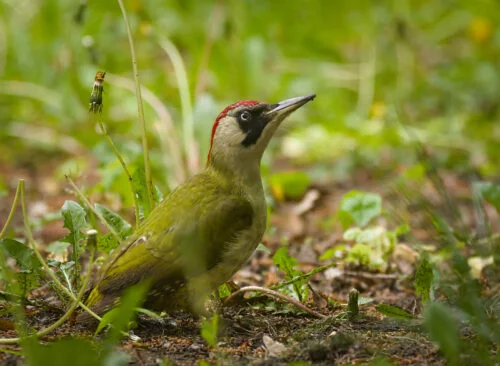
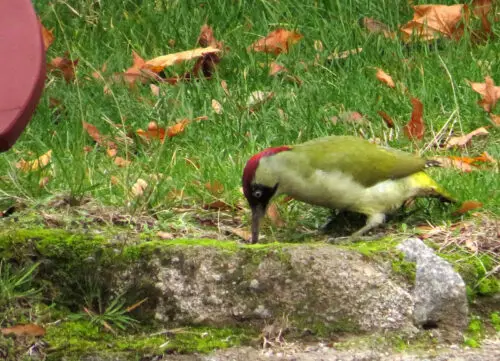
In a land known for its vibrant tulip fields, historic windmills, and intricate waterways, the Netherlands also offers rich melodies and colors of the avian world. One such vivid performer is the Eurasian Green Woodpecker, a bird that with its dazzling hues and infectious laughter, brings a touch of whimsy to the Dutch landscapes.
Cloaked in brilliant shades of green with a dash of red on its crown (and a vibrant red moustache for the males), the Eurasian Green Woodpecker is nature’s masterpiece. Its striking appearance, combined with its undulating flight, makes it a joy to spot and a favorite among bird enthusiasts.
The Netherlands’ diverse habitats, from the sandy coastal regions to the dense forests of the interior, provide a suitable stage for this woodpecker’s antics. It has a special fondness for open woodlands, parklands, and gardens, making regions like the Veluwe and the forests of Limburg its favorite haunts.
Not just a visual delight, this bird is an auditory gem as well. Its unique “laughing” call, reminiscent of hearty chuckles, has earned it the nickname “yaffle.” On a quiet day, this laughter can ring out, breaking the stillness and bringing a smile to anyone in earshot.
While ants make up a significant portion of its diet (it’s often seen feeding on the ground, unlike its tree-drumming cousins), the Eurasian Green Woodpecker also relishes insect larvae, spiders, and occasionally, fruits and nuts.
In Dutch folklore, the Eurasian Green Woodpecker’s laughter is considered an omen of rain, a predictor of nature’s moods. Its vibrant presence and jubilant calls have also inspired numerous poems, songs, and tales, celebrating its spirit.
For those traversing the lush paths of the Netherlands, the Eurasian Green Woodpecker stands as a reminder of the country’s diverse and vibrant natural tapestry. Its jubilant presence underscores the joy and wonder that nature, even in its most familiar settings, brings to our lives.
6. Black Woodpecker
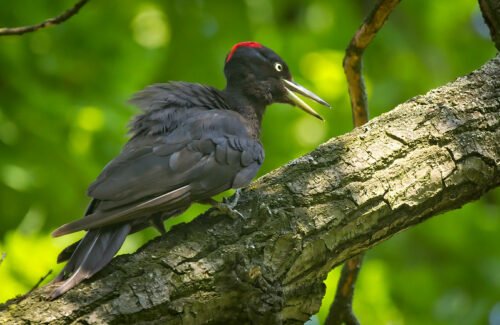
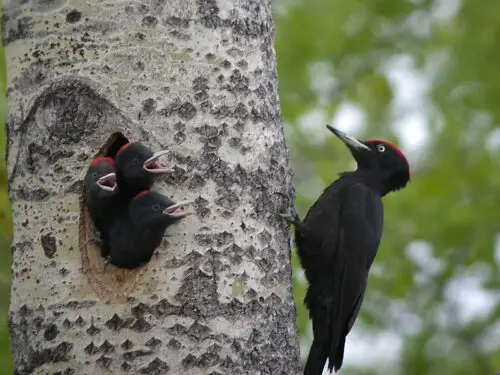
The Netherlands, renowned for its art, cycling trails, and sea of flowers, is also home to one of nature’s most dramatic avian wonders: the Black Woodpecker. With its deep ebony plumage and striking presence, this bird commands attention and respect, almost like the knights of old Dutch tales, standing tall amidst the realm of birds.
Enveloped in a deep black cloak, the Black Woodpecker is one of the largest woodpeckers in Europe. Its bright crimson cap, especially pronounced in males, serves as a sharp contrast, making it easily distinguishable against the soft greens and browns of the Dutch forests.
These woodpeckers are a testament to the pristine, untouched patches of woodland that the Netherlands conserves with pride. Primeval forests, with their age-old trees and intricate undergrowth, are their preferred domains. Places like the ancient forests in Drenthe or the dense woodlands of Noord-Brabant are where they feel most at home.
Armed with a beak like a chisel, the Black Woodpecker drills deep into tree trunks, seeking out its primary diet of ants and wood-boring insects. The sound of its hammering, deep and resonant, is often the first indication of its presence to an unsuspecting wanderer.
Dutch stories and poems often portray the Black Woodpecker as the guardian of the forests, its resonating drumming being a call to protect and respect the land’s natural heritage. There’s even a belief among some locals that hearing the bird’s drumming ensures good luck and a day of adventure.
For those exploring the Netherlands’ verdant terrains, the elusive sight or echoing call of the Black Woodpecker is an enriching experience. It serves as a reminder of the wild, untamed beauty that persists amidst modern landscapes and urges us to cherish and protect these vestiges of raw nature.
